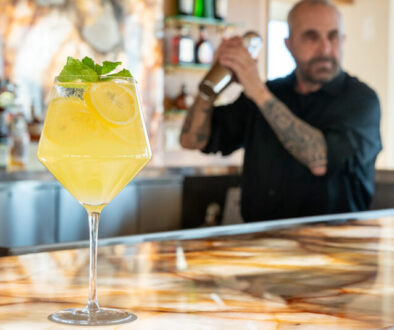50 Summers Later
Glynis Rickard and Louise Hudson recently revisited Cape May from Ireland after 50 years to reminisce on their summers abroad working in America in the early 1970s.
Glynis Rickard and Louise Hudson recently revisited Cape May from Ireland after 50 years to reminisce on their summers abroad working in America in the early 1970s. Typical of a storybook journey, these Irish girls faced the unknown head-on in search of experience and exploration. They received kindness and guidance from strangers as they enjoyed their summer work in Cape May and other adventures throughout the country.




The summer of ’73
It all began in 1973 Ireland when Glynis and Louise were coming home from college. On the bus ride, a friend of theirs introduced them to the working abroad opportunities in America, specifically in the charming seaside resort of Cape May. “It sounded great, so we got the details of who to contact from her,” said Glynis.
Cape May is a long way away from their home base of Bangor, County Down, a City in Northern Ireland on the southern side of Belfast Lough—but they got their ducks in a row and set off for the voyage along with two other girls from the same area. “Heather is Louise’s sister, and Carole was a school friend of ours and at college. We all knew each other well so we decided to go together,” said Glynis. They applied to the Christian Admiral and Congress Hall, both owned and operated by Carl McIntire, a fundamentalist preacher, radio host, and hotelier at the time.
“Once we had a letter offering us jobs, we went to the students’ union. The USIT office [a leading organization specializing in helping Irish people find work abroad programs] organized our visas, flights, accommodation and orientation in New York, but we paid for it ourselves,” said Glynis.
The four young women set off from Dublin in early June to work for McIntire until Labor Day. Glynis mentioned how the Christian affiliation of the job positions offered a sense of acceptance and trust for her parents. “It was worrying for our parents. Louise’s parents had never flown or even been outside the UK and they watched us jet off to the great unknown! We could only communicate by post then. However, it was extremely exciting for us—flying in a jumbo jet, staying in New York, then travelling by bus to Cape May,” remembered Glynis.




Glynis, Louise, Carole and Heather at Congress Hall in 1973. At The Windsor Hotel with their manager Jim. Dressed up for Gail’s wedding in 1974.
They worked at The Windsor as well, also owned by Carl McIntire. “The four of us painted the walls, cut the hydrangeas, and did all the floors,” recalls Glynis. They were transferred to Congress Hall when The Windsor building was closed after failing fire inspection. A few years later in 1979, The Windsor would burn down.
“At Congress Hall Louise and I worked a floor, Heather worked a floor, and Carole ended up in the linen room. If anyone needed to have a room done it was ‘get the Irish girls;’ we were always on site,” said Glynis. “We were just known as the Irish girls.”
Standout memories and important figures that Glynis mentions from their first visit in the summer of 1973 are the Goldmans, owners of a doughnut shop that she believes was in the mini mall on Washington Street. “The four of us went nearly every night for tea and doughnuts. We got to know their daughter Gail well and we cleaned for Mrs. Goldman.” They attended Gail’s wedding a year later in Cape May. Glynis emphasized that on her return trip 50 years later she couldn’t find any trace of this doughnut shop or even a local who remembered it. “My biggest disappointment was that I couldn’t find this shop on my recent visit.”
“We used to go up to the Christian Admiral and have our Sunday lunch and we also frequented the Christian coffee house, The Lighthouse. It was located next to the Assembly of God church that is today Panico’s Bistro. This is where we first met students John and his friend Ted,” remembers Glynis. Their friend John eventually brought them on a trip to Denver, but not quite yet.
The Irish gals had no trouble making friends. In fact, the bonds they formed were so strong that it led to more than one cross-country trip. “We became friends with many of the summer staff, some of whom took us to Washington on a sightseeing trip. Philip [a friend they made in Cape May] went to college in Florida and offered to take us there for a holiday. He drove Louise and Heather down and Carole and l went on the bus,” said Glynis. This memorable autumn road trip introduced the girls to significant staples of American culture: a traditionally celebrated holiday and the nation’s most popular entertainment complex. “His Mum made us a Thanksgiving dinner, and the boys took us to Disney World, the Kennedy Space Center, and Silver Springs [State Park]. It was a wonderful end to a great summer,” she remembers.
They returned to Ireland with souvenirs, fond memories, and the hopes that it would not be the last they would see of Cape May.
Back for more in ’74
“Louise and l were truly overwhelmed by the kindness shown to us during both our summers.”
Glynis and Louise made positive impressions during their first visit to the States. They returned for their second summer with a sense of excitement—and a little more confidence. Their first summer here had been a whirlwind of new experiences, but the friends they made welcomed them back with helping hands and familiar smiles.


This time around they had friends to rely on for sponsorships and housing, but they did not have jobs in place. Their sponsors housed them briefly in Philadelphia and when they arrived back in Cape May their friends put them up at Congress Hall.
They went door to door in search of jobs and eventually secured positions as chamber maids at The Colonial Hotel, now known as The Inn of Cape May, where they met an important figure who offered the girls guidance beyond the job description. “Our housekeeper Harriet became like a second mother to us. And I corresponded with her until she died,” said Glynis. “She bought us Cape May diamond bracelets when we left that year.”
“We made reasonable money and tips. The dollar was very strong, and it was two and a half dollars to the pound, so we went back with candles and scented stationery. We had never seen anything like it. We bought dresses and swimsuits and presents,” said Glynis. The value difference between the dollar and pound is currently considerably less.

Glynis recalls strolling along the beautiful beaches nightly with Louise. They collected shells and saved them in jars, encasing a bit of Cape May that she has kept to this day. “The beaches here are so clean and lovely,” she said.
They left earlier in 1974, departing from Cape May in August to prioritize a bit of traveling with friends. A waitress the girls had befriended from Congress Hall named Kathy drove them to Philadelphia and hosted them for a weekend before Glynis and Louise hopped on a train headed for Denver where their dear friend John awaited them.
“Whilst staying with John and his family he took us on trips to Vail and Estes Park and drove us to Utah through some fantastic scenery to see his brother in Salt Lake City,” said Glynis. “Louise’s birthday was in early September and John and another brother, Garry, treated us to a celebration meal in a restaurant called Top of the Rockies. A fabulous experience and a wonderful memorable holiday.” It was another summer wrapped up with an adventurous trip of some of the best sights America has to offer.
Among their travels throughout the United States, Cape May holds a special place in their hearts. Those formative summers created memories to last a lifetime. They may have left Cape May, but Cape May had stuck with them.


50 years later, the Irish girls return
Fifty years had passed since Glynis and Louise first set foot in Cape May. The years had flown by, but the memories had remained—vivid and timeless. They had been two Irish girls, wide-eyed and eager to explore, and Cape May had welcomed them like a second home. With its Victorian allure and quiet tree-lined streets, this unique town has a way of standing still in time. After half a century, they returned full of nostalgia and curiosity about what had changed and what had stayed the same.
“It was the realization that this is 50 years, if you’re gonna do it, do it now,” said Glynis on what prompted their return trip. Of the many connections they made in Cape May, John is a friend they continued to correspond with over the years. “I sent Christmas cards to everybody that we met and worked with, and he [John] was the only one that got back. We’ve tentatively managed to keep hold of each other over the years. He came from Oklahoma to meet us,” she said. So, they told him about their plans, and he matched their vision by traveling with his wife to join his longtime and long-distance companions.



“John drove us down from Philadelphia and left us at our hotel. We went out to explore the town. We walked straight to Congress Hall and sat on the rocking chairs in the sun, with a glass of prosecco in hand. I felt we’d made it!” said Glynis. “Congress Hall shone like a beacon of sunshine. We were mightily impressed that our dingy rooms had been transformed into the beautiful Perry Wing. Louise’s room had overlooked the Pink House, which was now even pinker! Not only had we completed our journey safely, but instead of being poor working students, we were now ladies of leisure holidaying in Cape May. Our dream had come true.”
Much has changed in Cape May over the last 50 years. Two hotels where the girls had worked, Christian Admiral and The Windsor, are no longer here. Congress Hall has undergone a significant and expensive makeover, and The Colonial is now the Inn of Cape May. But much has also stayed the same, along with Cape May’s historic appeal. The preserved Victoriana allows for the essence of Cape May to stay alive and makes it feel like you never left regardless of how long it’s been.
Some changes stood out to Glynis, “The Colonial looked just the same but a different color. However, the two houses at the back, where we lived, are so much prettier today. We lived in one house and the boys all lived in the house next door. The owner’s brother lived below us so there was no hanky-panky,” she said. The women recreated a photograph of themselves dressed up for Gail’s 1974 wedding in front of the two houses.

“The town in general and the mall in particular looked very bright, clean, and colorful,” said Glynis. “The beach seemed much wider to us, but again we were impressed by how clean it is.”
John was also delighted by this trip down memory lane. He said it was lovely to see the old sights like beaches, the promenade, the lighthouse and the concrete ship. “In the early 70s it was becoming a bit tired with some significant dilapidation of its Victorian appearance. Now it is really revived and vibrant. It has a resort feel with a lot of Victorian charm and character,” said Glynis. “We thoroughly enjoyed our trip and can recommend the fabulous bed and breakfast, The Hugh.”
The Irish girls’ reunion with John and Cape May 50 summers later was a joyful success. Glynis is a woman who treasures her memories and honors the past. She has kept so many artifacts and pictures that bring her back in time, appreciating that where she has been has made her who she is now.



